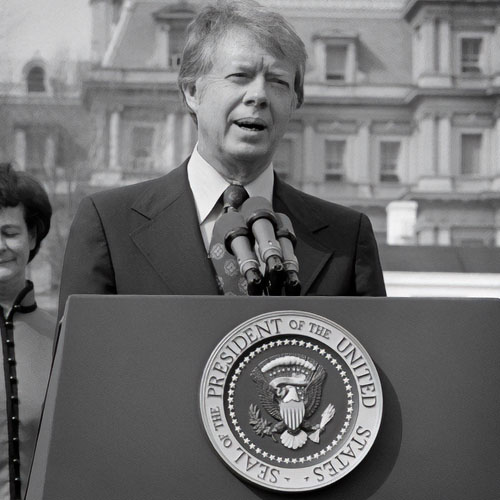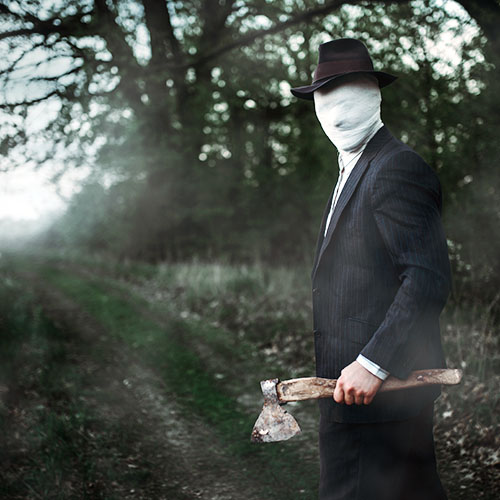Was Travis Walton shanghaiged aboard a UFO be a band of Dwarfish, intergalactic “creatures”? Eyewitnesses say he was. But many of his neighbors in Snowflake, Arizona, think it’s a con-job, and the controversy has torn the town apart.…
Unidentified Penthouse Objects
It happened in Indian-country, high in the rocky timberlands of the Sitgreaves national Forest, 156 miles northeast of Phoenix — a rugged, desolate, pinewood mountain range of primeval beauty. This is the ancient home of the Apache and Navaho and Hopi, all steeped in misty centuries of sacred lore that tells of mysterious spirit creatures who journeyed down from the skies. They winged their way on engines of clouds that flashed. And sometimes they departed on ships of rock, carrying away human warriors they had taken from the tribes.
Mike Rogers had a Forest Service contract to thin out 1,277 acres of scrub. His crew consisted of Travis Walton, Ken Peterson, Alan Dalis, Steve Pierce, John Goulette, and Dwayne Smith. Three men cut with roaring chain saws, and three followed behind, piling the debris. Rogers supervised.
On November 5, 1975, he was behind on his contract. So the crew worked until last light, about 6:0 p.m. They were bone-tired when they finally stopped and climbed into Rogers’s crewcab International truck for the ride home to Snowflake, a small Mormon settlement town thirty miles north. Rogers drove, Peterson and Walton sat beside him on the front seat, and the four others sat in the back.
They were moving slowly at about four miles per hour over the old, hump-backed logging road, joking about going swimming in Snowflake’s heated indoor pool. The night was clear and crisp; the temperature, in the mid-forties. The truck had gone only about 100 yards when Alan Dalis leaned out from the backseat passenger window and said: “What the hell is that out there?”
Light was glowing inside the thicket of jack pines that they were passing. To Travis Walton, the glow first looked like the sunset, even though it was not seen on the western horizon. Smith thought that it might be a crashed airplane hanging in the trees. Somebody said, “Maybe it’s a hunter’s camp, a fire, headlights.”
The truck came around a small bend. To the right was a clearing. Three slash piles (logging debris) were in the clearing, which was all lighted up. Suddenly, all the guys sitting on the right side of the truck stopped talking, and somebody blurted: “Stop the truck!”
Travis Walton had already opened his door, jumped out, and was running into the clearing. Mike Rogers cut the engine, leaned to his right to see out the window, and there it was: hovering 15 to 20 feet above one of the slash piles, about 100 feet away It was glowing milky yellow, almost the color of hot molten iron coming out of a blast furnace. Its structure was about 20 feet in diameter, an oval, 8 feet from top to bottom, with a milky white dome on top.
It hung motionless and silent, below the tallest trees, not near the trees. During the first seconds nobody said a word. They just starred at the object, dumbstruck.
Abruptly, Mike realized that Travis was walking directly toward it. That just looked like a dangerous thing to do. So he hollered: “Hey, what the hell are you doing?” Then the others yelled: “Travis! Get the hell away from there — Come back from there! “ Some of them heard a high-pitched beep, like the warning bell on an airliner when the captain switches on the seat-belt sign. Travis stopped at the slash pile. The object hung just over the opposite side. He stared straight up into its golden-glowing underside. It was smooth, without ports or hatches, without bolts or rivets. It looked like a huge light bulb. It was beeping.
And then it made a louder noise. It rumbled, as if it were coming alive. And then it moved. Travis dropped to his knees, hiding behind a log sticking out of the trash pile. The rumble grew louder, like a turbine generator winding up to full power, rising in pitch. The object was spinning slowly, rocking, wobbling, gaining speed as if it were going to take off.
The guys were all screaming at Travis to come back. They could feel the rumble now Travis glanced at the truck, started to stand up, as if he were going to get the hell out of there. Suddenly, a beam of brilliant light blazed out; it blasted the whole area bluish white.
Peterson and Dalis saw the shaft of light streak out of the craft’s bottom and hit Travis in the head and chest. He shot straight up one foot off the ground, stiffened, his head thrown back, his arms and legs flung out, his whole body silhouetted in sharp light, and he was hurtled backward and banged to the ground ten feet away, just as if an explosion had gone off in front of him.
The guys were screaming at Mike: “Get the hell out of here! Get out of here!” He was already hitting the gas pedal, mashing it to the floorboards, and the truck careened down the humped road, bucking berserkly. Pierce was wailing. Dalis was trying to hide behind the front seat. The others were shouting and praying aloud. Mike was just trying to get them out of there, fleeing in a blind panic, so scared that he could hardly see, his fingers and feet numb, nausea flooding into his stomach and throat.
“Is the damn thing following us?” he screamed. All he could see in his jouncing rear-view mirrors was wildly bouncing light. He was sure that the thing was right on their tail, and he was driving like a maniac to get away from it, oblivious of the way he was speeding. He couldn’t even see the road. Suddenly, a huge pine tree loomed up in the headlights. He swerved the wheel, missing the tree, and the truck came to a Jerking halt, straddled crossways on a bulldozed-up mound of dirt.
Nobody could see it. It wasn’t following them. They sat frozen, wordless, catatonic. Mike was ready to take off again if he saw even a glimpse of it. Just ahead was the rim road, the way out of the forest. They had gone about a quarter of a mile.
Nothing happened; so they all climbed out of the truck. Dalis was running his mouth at 100 miles an hour, making absolutely no sense at all. Pierce was crying and wouldn’t respond to any questions. They stood there in a hubbub of words, screeches, a complete hysterical turmoil, utterly confused and terrified.
Kenny Peterson had a blank look on his face. Kenny, twenty-five, and Mike, twenty-eight, were the older, surer, most respected members of the crew. Kenny finally exclaimed: “What in the hell are we doing? Do you realize that Travis is still back there? We just ran off and left him. What in the hell happened to him?”
For the first time Mike realized what they had done. “We’ll have to go back and get him,” he said. But Pierce, Smith, and Goulette flatly refused to go back. Nor would they wait where they were, alone, either. They pleaded with the others to drive out to Heber and get the sheriff. Mike and Kenny said that they were going back. Travis could be hurt, or he could be lying there dead. They were going to find out, one way or the other.
As Mike got to his door, he saw a flash of light take off from the woods behind them and disappear into the black sky He was sure that was it, sure that it was gone. It just lifted straight up and Pfffft! It was gone — a streak and a blur and then empty sky
They drove back to what they thought was the spot. Many of the clearings looked the same. They drove in slowly, shining the headlights on the slash piles. Kenny had the flashlight out, shining it around. There was no sign of Travis.
“We’d better get out and look around” Mike said. They argued a little about getting out of the truck. Finally, Mike got out and the others followed. They stayed close together, searched all around the slash piles, then circled up through the woods to the ridge, searched the ridge, and then traced back again. They found no sign of Travis, no tracks, no blood, no clothing, nothing. They kept looking for about half an hour. Mike broke down. Travis was his best friend. He fell to his knees, crying.
Then they drove out of the woods, down to the nearest town, Heber, to get some help. About 7:45, Navajo County’s deputy in Heber, Chuck Ellison, got their call. He summoned the sheriff, Marlin Gillespie, in Holbrook, forty miles away Gillespie hurried over with his undersheriff, Ken Coplan.
All the witnesses told the same story. They were all upset. One was crying. If they’re lying, Ellison thought, they’re damned good actors. So Sheriff Gillespie decided that they’d go back and search some more with flashlights and a spotlight. But they found nothing. Near midnight Mike said: “We’d better tell his mother.”
So he and Deputy Coplan drove over to her isolated ranch at Bear Springs, about eleven miles east in the woods. Mary Walton Kellett was preparing to move back to her house in Snowflake tor the winter. She was alone, and when she heard the car drive up, she came to the door with a gun. Mike looked as if he were having a nervous breakdown; she knew that something was wrong.
“Have you seen Travis?” Mike asked.
“Why no, not since I saw him in town last time I was there, a few days ago. Why? What’s wrong?”
Mike told her the story She had him repeat it again. Coplan didn’t like her reaction or, rather, her lack of reaction. She didn’t cry, wail, scream; she showed no visible reaction at all. That looked suspicious to him.
“Let’s go to town,” she said. “I’ll have to tell the children.”
There were six children, all grown. She had raised them by herself, after her husband had run off with another woman. In order to support them, she had operated a fifteen-room boarding house and an answering service in Phoenix. Then she raised five foster children, three of them Apache sisters, until illness struck her down, leaving her partially crippled. She was part Cherokee, stoic in the face of trouble, stronger in spirit than many of the mountain men were. She was a doer, not a crier. Hysteria only got in the way of doing what needed to be done.
Her older son, Duane, was asleep in his suburban Phoenix home when the phone rang. Minutes later, he was driving hell-bent for Snowflake. It is a rugged drive: through the empty desert, into the rocky buttes, climbing ever higher into timber country, over snaky hair-curve roads with falling-rock zones on one side and straight-down mountain plunges on the other. The road finally emerges onto the high plateau named Mogollon — a frontier of vast, rolling prairie, harsh, isolated, brooding, both beautiful and forbidden. The elevation pops the ears at 6,000 feet. And on a clear night. you can see forever across the endless skies. In these skies people have watched strange and mysterious lights for years.
Named for its Mormon founders (1878), Erastus Snow and William Flake, Snowflake is a dusty Last Picture Show town. The town marshal is Sanford (”Sank”) Flake. The resident Navajo County deputy is his brother, Glen Flake. Their families control ranches, The Emporium, The Feed Bag restaurant, and a few other holdings in a town that is only a couple of blocks long. One full square block is occupied by the Mormon Church of Jesus Christ Latter Day Saints, which is hewn from huge slabs of copperytinted rock. Nearby is the town’s biggest business — the Snowflake Union High School campus and stadium, home of the Lobos.
A block off Main Street is farm country: horse ranches, cattle, pigs. There is a feed mill and a lumber mill. Some 4,000 people are spread about the surrounding countryside. The men wear cowboy hats and cowboy boots. In the evenings they drive their pickup trucks back and forth on the darkened main street. The next full towns are twenty-seven and thirty-five miles away. At night the wind whistles across the bare winter earth, chilling the graybeard grasses. Woodsmoke curls up from every chimney. And very late the baleful wail of a southbound freight echoes through the silence. It is a lonely place.
Duane arrived before daybreak and took charge for the family. That morning Sheriff Gillespie mounted a full-scale search. During the succeeding days fifty men on foot scoured a two-mile-square area; then horsemen expanded the area; four-wheeldrive jeeps were used and, finally, a helicopter. No trace of Travis Walton was found, and there was no sign that any craft had landed at the “abduction” site: there were no broken branches, no ground burns, no pod prints, no significant radiation.
Three days later word finally leaked to the outside world. One of the first outside investigators to arrive was Fred Sylvanus, director of the Arizona Regional UFO Project. The project is based in Phoenix, which is the home of a number of respected UFO experts.
Sylvanus tried to interview Mike Rogers, but Duane Walton excitedly interrupted Mike’s description of the UFO: “I saw one almost identical to what they describe,” Duane said. “I saw it for a period of almost thirty minutes in broad daylight, about twelve years ago at one o’clock in the afternoon, about eight miles from this location right here. And it followed me around these woods for about thirty minutes, and it was never more than 200 feet from me at any time.”
Duane was six foot three inches, about 240 pounds, a boxer and a horseshoer, quick of mind and tongue. “Pushy” is what some people call him. His interruptions were beginning to irritate Sylvanus. But the investigator’s alarms went off when Mike said that Travis ran right under the craft, and Duane blurted: “Travis and I discussed this many, many times at great length, and we both said that we would immediately get as directly under the object as physically possible — We discussed this time and again.
The opportunity would be too great to pass up, and at any cost, except that of death, we would make contact with them. And whoever happened to be left on the ground, if one of us didn’t make the grade, we’d try to convince whoever was in the craft to come back and get the other one. He performed just as we said we would, and he got directly under the object, and he’s received the benefits for it.”
Sylvanus, a veteran UFO investigator, smelled a rat. “Unusual” previous interest in UFOs forewarned of tainted stories. Although Sylvanus suspected a hoax, Sheriff Gillespie more and more suspected murder.
There had been bad blood between some of Rogers’s workers, especially between Travis and Alan Dalis. Travis could have been killed during a fight, then buried, and the entire UFO story could have been concocted to conceal the murder.
Two factors nagged his theory: he had seen possible UFOs himself; so the story was feasible, if not probable. And a conspiracy of either hoax or murder seemed unlikely for this mixed-bag crew. Both Mike Rogers and Ken Peterson were known as utterly trustworthy, straight arrows. Steve Pierce at seventeen was still a boy and not personally close to anybody in the crew. Dwayne Smith was from Phoenix and had been on the job for only three days. This was not a close, tight-knit group by any means. And their stories all remained the same.
On Monday they were given polygraph tests by Cy Gilson of the Arizona Public Safety Department. He asked each of the six witnesses four basic questions:
- Did you cause Travis Walton any serious physical injury last Wednesday afternoon?
- Do you know if Travis Walton was physically injured by some other member of your work crew last Wednesday?
- Do you know if Travis Walton’s body is buried or hidden somewhere in that Turkey Springs area?
- Did you tell the truth about actually seeing a UFO last Wednesday when Travis Walton disappeared?
Gilson reported: “Each of the six men answered no to questions 1, 2, and 3. And they each answered yes to question 4. The test results were conclusive.” Five of the men were telling the truth. “The polygraph examinations prove that these five men did see some object that they believe to have been a UFO, and that Travis Walton was not injured or murdered by any of these men on that Wednesday If an actual UFO did not exist, and the UFO is a man-made hoax, five of these men had no prior knowledge of a hoax. No such determination can be made of the sixth man, whose test results were inconclusive.”
The sixth man was Alan Dalis. Gilson said: “He was obviously agitated. He was belligerent. He was the only one of the six who wouldn’t cooperate. I couldn’t make heads or tails of any part of his test” Unknown to Gilson, Dalis was an accused burglar and most fearful of being asked something in relation to his secret life. Months later he was convicted of armed robbery and jailed at the Arizona State Penitentiary. At this time, authorities say, he confessed to everything he had ever done in his life but stuck absolutely to his UFO story.
Meanwhile, Town Marshal Sank Flake publicly announced his opinion: “I think the whole thing is a hoax, set up by Travis and his brother, Duane, to make some money. I believe the other kids did see something, but they were hoaxed, too. What they saw was an inflated rubber raft, or something like that, all lit up and hung in the trees to look like a UFO. Travis set them up, telling them stories about UFOs; and when he had them ready, it happened.”
Duane Walton said Flake was prejudiced because the Waltons were not descended from original settlers. They were a high-spirited family and had had some scrapes in town. Travis had been a wild teenager whose IQ tested out to genius in high school.
Meanwhile, Flake was heaping fuel on the fired-up rumors that the whole Walton family was obsessed with UFOs: “They talked about it all the time. His mother.told me she saw them all the time. She saw a whole fleet of them flying in and out of her ranch one night. She said she just sat there on the porch and watched them.” The press jumped all over the accusation. The Waltons were UFO buffs; therefore, they reasoned, the abduction story was a hoax.
Marshal Flake did not tell the press that he had once been chased by what he thought was a UFO: “I was just a kid and working the [late] shift at the lumber mill. Just before dawn I was driving home with a friend when we saw this light rise up over the trees on the ridge behind us. It seemed to follow us, and it scared the hell out of us. We raced home to wake up our families. It followed us all the way. But it was just a star, I’m sure. I’m convinced it was just a star.”
Flake explains the many UFO sightings he’s heard about as, “just things that happen everywhere, all the time. But they’re just stars, or people are mistaken about what they are seeing. A lot of people around here believe in them, though. And that’s what Duane and Travis took advantage of.”
Sank Flake’s brother, Deputy Sheriff Glen Flake, began as a disbeliever. Teamed with Ken Peterson, searching the ridge, he tried to kid Ken out of the story, saying, “Come on, where’d you hide the body, heh?” But Kenny was as serious as a hen laying an egg. “He didn’t want to kid about it. He was concerned, and he was definitely looking for the missing Travis.’’ Glen became a believer. But events were about to confound his belief. Five days after. the disappearance, about midnight, the phone rang in Grant and Allison (Walton) Neff’s home in Taylor, three miles outside Snowflake. Grant, Travis’s brother-in-law, answered. “This is Travis,” a strained voice said. “I’m in the phone booth at Heber. Get Duane and come and get me!”
TRAVIS WALTON’S STORY
“The slash pile stopped me from getting directly beneath it. It was glowing this yellowish-white golden color, like a huge light bulb — A sound was coming from it, not very loud, like beep-beep-beep. Then I heard Mike, or somebody, holler, ‘Get away from there!’ And I looked around at them. When I looked back at the craft, it suddenly made a real loud noise, and it started to move, like it was coming alive, kind of an erratic spin-type movement. I jumped down behind this log, and I made up my mind right there. I was going to get the hell out of there.
“I stood up, and as I turned to go, I just felt this — electric shot, and a blow, like I’d been hit with a baseball bat. It all happened very fast. Then I went out.
“I don’t know what happened after that, but when I woke up, I was lying on my back. There was a light about three feet above me — I couldn’t focus my eyes, and I had a lot of pain, in my head and chest mainly, but all over. I kept going in and out.
“When I regained consciousness, I could hear movements around me. So I looked and saw these creatures standing there. I just came unglued, became hysterical. They were short, maybe five feet, with large, domed heads — very large, bald. They had these enormous brown eyes — oh, man, those eyes — they just stared through me. They didn’t have any eyelashes, no eyebrows, and their mouths and ears and noses seemed real small, maybe just because their eyes were so huge. They were wearing loose coveralls, orangish-brown, tan.
“I jumped up, screaming at them, and this thing fell off my chest. It was like a thick plastic strap that went halfway around me.
When it hit the floor, it rocked back and forth. A light came from beneath it, but there weren’t any wires or tubes in it. When I jumped up, I hit this one creature on my right, pushed him back, and he fell real easy into the next one. They had this white, marshmallowy skin, and their bodies were real lightweight.
“I couldn’t stand up very well. I staggered back against the wall. There was a shelf on the wall, and I grabbed this clear tube from it and tried to break the end off it for something sharp to defend myself with. It was too light for a club. They started toward me, and when that tube wouldn’t break, I just lashed out at them with it, screaming stuff like: ‘Get away from me! What are you? What’s going on here?’
“I was just hysterical. They stopped and kind of thrust their hands out, like they meant no or stop or something. They didn’t try to attack me or anything. Then they all just turned and walked out, hurried out. Shoo! they were gone.
“This room was really hot. The air was so wet and heavy I could hardly breathe. And my mind was just raging the whole time. I felt like I was burned, inside and out, and I ached all over, too, like I’d been crushed —
“Anyway, after a couple of minutes, I went to the door and looked down the way they had gone. It was a curved hallway that went right and left. I couldn’t see anybody. They had gone right; so I went down to the left. I just took off running and went right past another door. I wanted to find a way out, but I was just hysterical. That’s the one thing I had in my mind: get out of here. I was claustrophobic, frantic. But I finally got hold of myself a little and told myself to check out the next door. I ran up to it, on the right, and it was open; so I went in.
“It was just a round room with nothing in it, except a metal chair sitting on one center leg in the middle of the room. It was high-backed, and I was afraid there might be someone sitting in it. So I kind of sidled along the wall, until I could get a look into the chair. And a real funny thing happened.
“When I got closer to the middle of the room, it got darker. And when I stepped back, it got lighter again. When it got darker, I could see the stars-through the walls, the ceiling, the floor. Everywhere I looked.
“There was nobody in the chair. On the right armrest, there was a panel of buttons and a small, green screen with black lines across it. The left armrest had one lever on it. I wanted to find a way out of there, and across the room there were some rectangles on the wall, like they might be doorways, just cracks really. I thought if I pushed the right buttons, I could open the doors. So I punched a couple of the buttons, and nothing happened. Then I moved the lever — and the stars started moving all around; the lines on the screen moved. The stars stayed in their same patterns. They just moved all together, on the ceiling and through the walls.
“It was upsetting. I didn’t know what was going on. But I quit doing that. I was afraid I would really mess something up. I could really hurt myself. Then I heard a sound. I turned around, and there was a man standing there, near the door. He was a man just like a human being-not exactly Caucasian, but like a dark, evenly tanned Caucasian. He was big, over six feet, built heavy, and he was wearing tight-fitting blue coveralls, with a helmet over his whole head.
“He motioned me over to him with his right hand, and I ran up to him, screaming stuff like: ‘How’d you get in here? How do I get out? What is this?’ I thought he was American, just people, as far as I could tell. This helmet on his head was like a clear bubble, flattened on top, and it came down to his shoulders. There weren’t any wires or hoses or anything on it. He didn’t answer me; so I thought maybe he couldn’t hear me.
“He just kind of smiled, tolerant-like, and he took me by the arm and led me out of there. I thought, I’ll go with him, and maybe we’ll get someplace where he’ll take that helmet oft and he can hear me. His eyes were kind of strange, bright golden hazel.
“We went down that hallway and through some empty place, kind of an air lock. I thought we were outside. The air just got cooler, fresher; it felt like out of doors. And the light was much brighter, like sunlight. I felt really relieved, out of that heat, and I could breathe again.
“We were in this building, or larger craft, that had a high, curved ceiling. It was like a quarter of a cylinder on its side. The ceiling curved into one wall at one side, and there were three flat walls. There were two or three craft parked in there. They were shaped differently They were rounded, oval, and saucer-shaped, but they didn’t have any angles to them. They were smoother and shinier.
“We went through that room and down the hallway to another room, smaller. There were some other people in there, two men and a woman. They all looked like they were from the same family — They weren’t wearing helmets. Their hair was long, dirty blond.
“The first man put me in a chair and went across the room and out a door without saying a word. I was talking to these others, asking them questions, but they wouldn’t answer me either. They just kind of smiled at me. Their expressions hardly changed. Then the woman and one of the men took me by the arms and started to put me on a table. I was going along with it, but they wouldn’t answer my questions, and I started to resist, yelling: ‘Hey, hang on there a second!’ I was getting hysterical again. They just smiled, tolerant, like I was misbehaving. They weren’t mad or anything. They started to pull a mask down over my face, like an oxygen mask. I reached up to pull it off, and I went out
“That’s the last thing I remember till I woke up on the highway outside Heber. It was dark, and I saw one of those rounded craft hovering about four feet over the highway. I looked up just as a light went out, like a hatch closing, or just a light going out. And then it just shot straight up. I don’t see how anything could move that fast without shrieking. It didn’t make a sound. It was just gone.
“I ran down to the phone booths at the gas station, and I called my brother-in-law because he was the only nearby one in the family with a phone.
“Then I just slumped down in the booth, thinking about it. I couldn’t get those eyes out of my head. They were big, glassy eyes, hardly any white in them, all brown. When they blinked, it was like shades on a window going up and down. I didn’t want to look at them, and I couldn’t avoid them either.
“I was really tired and really thirsty, but I didn’t hurt so much anymore. I just burned and ached a little bit. That’s how Duane and Grant found me, stuffed down in that phone booth. They took me back to my mother’s house in Snowflake. On the way somebody said something that struck me funny, something like how everybody had been worried about me. And I said something about how it had only been a couple of hours. And Duane said, ‘Travis, feel your face’ I had a real heavy growth of beard.
“And he said, ‘You’ve been gone five days’ — ”
After stopping at his mother’s house, Duane drove Travis to his own home in Glendale, a Phoenix suburb. Travis insisted on seeing a doctor. Bill Spaulding, of Ground Saucer Watch, sent them to Dr. Lester Steward, for medical help. But Steward turned out to be a hypnotherapist, not a doctor, and Duane took Travis back home.
Shortly thereafter, they received a call from Jim Lorenzen, international director of one of the most respected UFO investigating organizations, the Aerial Phenomena Research Organization (APRO). Lorenzen immediately arranged for Travis to be examined by doctors Howard Kandell I and Joseph Saltz.
The medical examination determined that Travis was not suffering from any unusual physical injuries: he had allegedly lost from ten to fourteen pounds but might have received some nourishment during his disappearance. Dr. Kandell noted “a 2mm red spot in the crease of the right elbow” that could have been a puncture wound, not inconsistent with the thorn wounds with which woodcutters are normally afflicted during their work. The wound was healing and approximately one to three days old. Dr. Kandell stated: “His condition was not that of a man who had been wandering around the woods for five days, but the possibility could not be ruled out.”
Late on November 11 Sheriff Gillespie questioned Walton: his story fitted exactly with the stories of the six witnesses. But Gillespie came away unconvinced. The National Enquirer and APRO assumed unofficial responsibility for investigating the case. The Enquirer paid hotel and test expenses.
On November 12, Walton was placed under regressive hypnosis by Dr. James Harder, a University of California professor of hydraulic engineering and research director of APRO. Under hypnosis Walton exactly recounted his original story, with increased detail, and without the intense fear previously evidenced in him. Harder concluded that he was not lying; it was not a hoax.
On November 15 the Enquirer hired polygraph expert John McCarthy to test Travis. But the polygraph measures stress, not lies. And Walton was obviously suffering from intense stress already. McCarthy said that he would take that into account. His questions dealt with the UFO story and the possibility that Travis had lied to Harder and Gillespie. McCarthy reached this conclusion: “It was obvious during the examination that he was deliberately attempting to distort his respiration pattern. Based on his reactions on all charts, it is the opinion of this examiner that Walton, in concert with others, is attempting to perpetrate a UFO hoax, and that he has not been on any spacecraft.”
However, Dr. Jean Rosenbaum, chairman of the Southwest Psychoanalytic Association and a court-recognized expert in the field, said the polygraph session was meaningless. Speaking for the half-dozen experts who had examined Walton at the time, he noted that “a comprehensive battery of psychiatric and medical exams was conducted on Travis Walton, and our conclusion, which was absolute, is that this young man is not lying, that there is no collusion involved. The [full test] results show he really believes these things, that he is not lying.
“He really believes he was abducted by a UFO. But my evaluation of the boy’s story is that although he believes this is what happened, it was all in his own mind. I feel he suffered from a combination of imagination and amnesia [transitory psychosis] — that he did not go on a UFO, but simply was wandering around during the period of his disappearance. But I’m unable to account for five witnesses having the same story and passing lie-detector tests about it.”
Subsequently, a whole new host of “hoax charges” arose concerning those tests. But by then the “facts” of the case had been mangled beyond easy redemption. Each “factual” error, distortion, misconception, falsehood, was automatically repeated in investigative reports and news stories. If the reporters had checked more carefully, they might have discovered how flawed some of this “evidence” was.
For example, “suspicious” statements allegedly made by Mary Walton Kellett “to troopers” at her ranch the night she was told Travis had disappeared were tracked back to Deputy Ken Coplan (the only “trooper” present). He denied that she had made the statements.
After laborious backtracking, Coplan was also identified as the original source for this story: before the “abduction” Travis had called a radio talk show and volunteered to be a guest. The talk-show host called him a kook. After the “abduction” Travis called again and said, “Now who’s the kook?” Coplan said he did not know of any such talk show; he denied making the original statement — which, by then, had become “evidence” against Walton.
Despite Duane Walton’s hyperactive statements to investigators about his UFO “pact” with Travis, if thorough investigation of the Waltons’ previous UFO interest showed a normal interest. which is shared by approximately 100 million Americans.
During Mary Walton Kellett’s polygraph lest, she was questioned most pointedly about being a UFO buff. She denied this, and the test indicated that she answered truthfully. But the test also indicated “animosity” toward Sheriff Gillespie in that regard. “Sure,” she admits. “He sat out there [at the search] and told me of two or three incidents when he had seen UFOs. Twice when he was out hunting in the woods. Once when he was escorting another car back to Holbrook. A lighted object ran the other car off the road. Later he came back, and the thing was still sitting there.”(Both policemen and other witnesses confirmed hearing Gillespie tell the same stories.) “Then he turns around and calls me a UFO buff, and everybody in the press picks up on that, like we’re all nuts, hallucinating or something like that. much, and we don’t claim to know what they are — It certainly doesn’t give us a reason
“Gillespie’s stories would have ruined him. He’s got an elected job. He doesn’t want to lose it by admitting that he knows there are UFOs. We have seen lights, lighted obJects, and almost everyone around here has seen them. We don’t discuss them much, and we don’t claim to know what they are — It certainly doesn’t give us a reason for creating a hoax. We had no reason for that. And we sure don’t have the money it would take to manufacture what all these witnesses say they saw.”
The accusers charged that Travis plied the work crew with UFO stories, until they were ready to “see what he wanted them to see.” But the witnesses deny this. Says John Goulette: “In the month and a half I worked on that job, it only came up once or twice.
Travis said that if he ever saw one out there, he’d try to communicate with it — We saw what we saw, and it wasn’t any story Travis had told us. ‘It was real.’”
So the controversy swirls about the little town of Snowflake and its most notable (if not most respectable) citizen, Travis Walton. No one can prove that he was abducted by a UFO; nobody can prove that he was not. Officially, the police have closed the case: the Walton story is feasible but not probable. If it turns out to be a hoax, the hoaxers will be prosecuted for creating public mischief.
Walton and Rogers say that people explain the story according to their fields of expertise: the cops see it as a crime, a hoax; drug experts see it as a drug experience; the psychiatrists see it as something in the mind, probably rooted in childhood fantasies and/or deprivations (a temporary psychosis somehow shared by six witnesses ). And Travis says: “The ideal UFO witness would have to be someone who was never in trouble, never saw anything mystifying before, never thought of UFOs, never spoke of them, never even heard of them at all. Maybe, just maybe, he’d be believed.”
So scratch one fifth-grader at the Snowflake school. His teacher noticed that the boy seemed sleepy and inattentive in class. She told him: “You’re going to have to stop watching television at night and go to bed on time.”
“I don’t watch television at night,” he replied.
“Then why are you so sleepy every day?”
“Because we watch the UFOs from my bedroom. Sometimes they’re back by the hills all night long.”
And other people see them. A drilling crew was working on the Glen Flake ranch, ten miles outside town, one night when a bright light suddenly popped on directly above the drill rig. The men all looked up, startled, and had to shield their eyes from the intense light. After a while, the light popped off, and the thing, whatever it was, was gone. Immediately, the foreman came racing down the dirt road from the highway, screeched his car to an abrupt stop, and quickly jumped out.
Trying unsuccessfully to be casual, he asked, “Did you, uh, fellas see what I just saw?”
They excitedly affirmed that they had and asked him what it was anyway.
“I don’t know what in the world it was,” the foreman said, “but I’m damned glad you saw it, too. I’d never have said a word about it if you hadn’t seen it.”
So it’s entirely possible that a lot more people have seen UFOs than will admit to having done so. Nobody likes being ridiculed. One woman, whose car was “just turned right off” by one, said: “No way I’m going to tell people about it, so they can say I’m out hallucinating on drugs at night. I’d die if that ever got around.”
Glen Flake said: “A lot of these people are — good, honest, reliable people — We’ve seen the lights. They’re maybe a half a mile off and moving. And then they just stop. Or they shoot off at crazy angles. I don’t know what they are — When I think about all the Walton story, all the for’s and all the against’s, I tend to believe it. Or, I can’t disbelieve it, like my brother does. I don’t believe it, and I don’t disbelieve it. I just don’t know what the truth is.”
And that is about where the evidence leads in the Travis Walton case.
One night, right in the midst of the full hubbub over the story, Flake was on desk duty at sheriff’s headquarters in Holbrook. “We were getting calls from all over the country about the UFOs,” he explains. “TV, newspapers, magazines. Even some from Europe. On the dispatcher’s radio the sheriff’s office in Pinetop broke in, and their deputies were talking about a blue-red-white light sitting out there, not moving, just changing color. They’re about sixty to seventy miles south of us. Then the St. John’s sheriff station came on, about sixty miles east of Pinetop, and they were watching the same thing. So we went outside and looked, and we saw it. too. It was just sitting in the middle of this triangle of sheriff’s stations, not going anyplace and changing color from red to blue to white.
“About then, we got a call from Boston, or Chicago, and the man says: ‘Have you seen any more UFOs?’ and he’s kind of laughing. And I said, ‘Sure, we’re watching one right now!’
“He nearly fell over, had me go out and check if it was still there. It was. ‘Well, what is it?’ he wants to know, real excited.
“I don’t know what it is. It’s just there, and it’s not moving, and it wasn’t there before. You tell me what it is.”
























